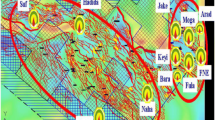Abstract
Solar Enhanced Oil Recovery (EOR) technique is one of the emerging technologies being adopted by exploration and production companies to achieve maximum oil recovery with less project cost and environmental effects. Usually, operators around the world use gas-driven generators to produce huge volume of steam to produce heavy oil reservoirs which are not only expensive but also produces carbon emissions leading to greenhouse gases. However, if this same quality steam can be generated through solar energy both problems can be tackled smartly. Thus, this paper aims to present solar potential for the northern field of Pakistan which is estimated through TRNSYS simulation software. Additionally, total incremental oil recovery is also calculated and compared with the different steam injection scenarios. Therefore, parabolic trough collector method has been selected to generate the required steam to heat the oil and reduce its viscosity. Three injection scenarios have been proposed (12-h injection, 18-h injection, and 24-h injection). All the scenarios have been compared against the base case and the best scenario has been selected based on optimum oil recovery. The results of this study suggest that solar generated steam in all the three cases produced more heavy oil, approximately 10% higher, as compared to the hot water steam injection method. In addition, the water cut has been significantly reduced to 21% which shows the effectiveness of solar generated steam over hot water steam. Moreover, while comparing the three solar generated steam cases, the maximum oil production is achieved through the Generation of Solar Steam with a Long-term Thermal Storage backup (Scenario#2) followed by the 100% Solar Steam Generation (Scenario#1) with only 2 to 3-barrel difference. The result further shows that the higher water-cut values approximately 35% are observed at the base case (hot water injection) in which only the hot water injection is carried out, when compared with all other scenarios. Nevertheless, it is obvious that the solar energy can be a best alternative to produce steam instead of burning the natural gas in Pakistan.











Similar content being viewed by others
References
Ahmed U, Meehan DN (2019) Unconventional oil and gas resources: exploitation and development. CRC Press
Akin S, Celebioglu D, Kalfa U (2009) Optimum tertiary steam-injection strategies for oil-wet fractured carbonates. SPE Western Regional Meeting. Society of Petroleum Engineers
Al Yousef Z, Aldaif H, Al Otaibi M (2014) An overview of steam injection projects in fractured carbonate reservoirs in the middle east. Journal of Petroleum Science Research 3:101–110
Chaar M, Venetos M, Dargin J, Palmer D (2015) Economics of steam generation for thermal EOR. SPE Kuwait Oil and Gas Show and Conference. Society of Petroleum Engineers
Deutsch C, Mclennan J (2005) Guide to SAGD (steam assisted gravity drainage) reservoir characterization using geostatistics. Centre for Computational Excellence (CCG), Guidebook Series, 3.
Green DW, Willhite GP (1998) In: Henry L (ed) Enhanced oil recovery. Doherty Memorial Fund of AIME, Society of Petroleum Engineers
Hasan AR, Kabir C (1994) Aspects of wellbore heat transfer during two-phase flow (includes associated papers 30226 and 30970). SPE Prod Facil 9:211–216
Ni X-F, Cheng L-S (2005) Calculating models for heating area of horizontal wellbore in steam stimulation. Shiyou Kantan Yu Kaifa(Petroleum Exploration and Development) 32:108–112
Satter A (1965) Heat losses during flow of steam down a wellbore. J Pet Technol 17:845–851
Schmalensee R (2015) The future of solar energy: a personal assessment. Energy Econ 52:S142–S148
Van Heel AP, Van Wunnik J, Bentouati S & Terres R (2010) The impact of daily and seasonal cycles in solar-generated steam on oil recovery. SPE EOR Conference at Oil & Gas West Asia. OnePetro
Acknowledgements
We would like to acknowledge the support of all the institutions/organizations who supported us in this research.
Author information
Authors and Affiliations
Corresponding author
Ethics declarations
Conflict of interest
The authors declare no competing interests.
Additional information
Responsible Editor: Longjun Dong
Rights and permissions
About this article
Cite this article
Qureshi, H.A., Muther, T., Ansari, U. et al. Feasibility study and modeling of solar generated steam for heavy oil recovery. Arab J Geosci 14, 1397 (2021). https://doi.org/10.1007/s12517-021-07828-3
Received:
Accepted:
Published:
DOI: https://doi.org/10.1007/s12517-021-07828-3




